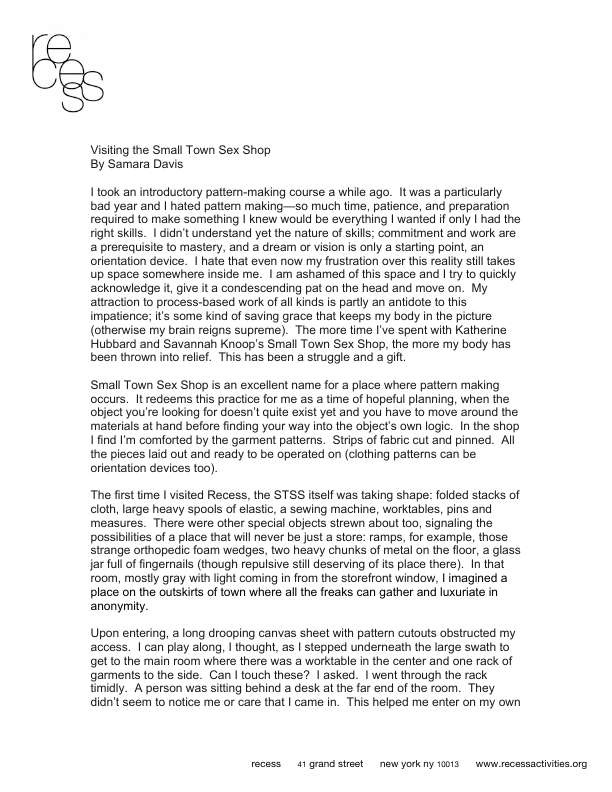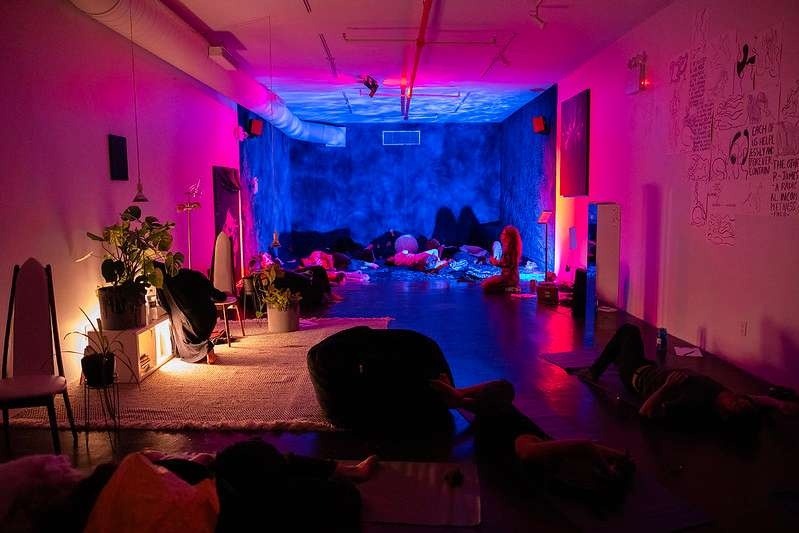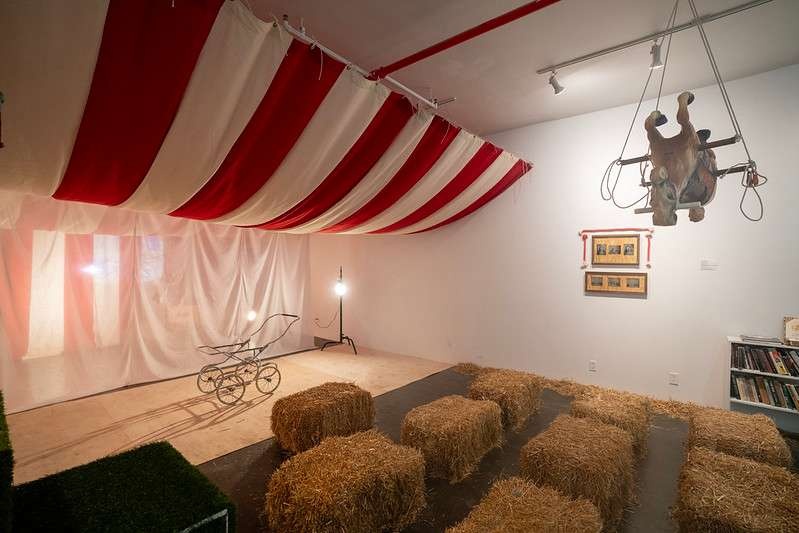Visiting the Small Town Sex Shop
By Samara Davis
I took an introductory pattern-making course a while ago. It was a particularly bad year and I hated pattern making—so much time, patience, and preparation required to make something I knew would be everything I wanted if only I had the right skills. I didn’t understand yet the nature of skills; commitment and work are a prerequisite to mastery, and a dream or vision is only a starting point, an orientation device. I hate that even now my frustration over this reality still takes up space somewhere inside me. I am ashamed of this space and I try to quickly acknowledge it, give it a condescending pat on the head and move on. My attraction to process-based work of all kinds is partly an antidote to this impatience; it’s some kind of saving grace that keeps my body in the picture (otherwise my brain reigns supreme). The more time I’ve spent with Katherine Hubbard and Savannah Knoop’s Small Town Sex Shop, the more my body has been thrown into relief. This has been a struggle and a gift.
Small Town Sex Shop is an excellent name for a place where pattern making occurs. It redeems this practice for me as a time of hopeful planning, when the object you’re looking for doesn’t quite exist yet and you have to move around the materials at hand before finding your way into the object’s own logic. In the shop I find I’m comforted by the garment patterns. Strips of fabric cut and pinned. All the pieces laid out and ready to be operated on (clothing patterns can be orientation devices too).
The first time I visited Recess, the STSS itself was taking shape: folded stacks of cloth, large heavy spools of elastic, a sewing machine, worktables, pins and measures. There were other special objects strewn about too, signaling the possibilities of a place that will never be just a store: sex ramps, for example, those strange orthopedic foam wedges, two heavy chunks of metal on the floor, a glass jar full of fingernails (though repulsive still deserving of its place there). In that room, mostly gray with light coming in from the storefront window, I imagined a place on the outskirts of town where all the freaks can gather and luxuriate in anonymity.
Upon entering, a long drooping canvas sheet with pattern cutouts obstructed my access. I can play along, I thought, as I stepped underneath the large swath to get to the main room where there was a worktable in the center and one rack of garments to the side. Can I touch these? I asked. I went through the rack timidly. A person was sitting behind a desk at the far end of the room. They didn’t seem to notice me or care that I came in. This helped me enter on my own terms; I could be attracted to whatever I wanted without anyone watching or caring or judging.
*
The single rack against the wall was like a curiosity cabinet of fabric—gauze and elastic straps suspended in so many creative entanglements. Somehow a long unwieldy pendulum, tossed over the pole and dragging on the floor, was the one object Savannah brushed over while showing us the other items. It was a shiny intricate mess and mass of metallic plastic beads and soft, knotted metal chains. Its long and scraggly mane of muddy gold (with specks of bright copper, red, and blue) was weighed down by the hard and bulbous shapes of a stuffed tube sock and cut-up tennis balls, all cast in bronze.
The pendulum wasn’t intimate like the other items, the ones you get close to and touch. Later Savannah would address it by saying something I kept with me but only vaguely. Her words were cast in a quivering and excited self-consciousness. I thought about this for days before asking her to explain it to me again. At the time I only retained something about dancing being like the pendulum, being like fucking, the only way to program—reprogram?—yourself the way you want. I somehow knew what she was saying before I could articulate it myself. I used to think dancing was the only time I felt free. This weighted beast hangs at Woahmone, the queer dance parties Savannah co-hosts. Even on that rack it allowed everything else to feel strange.
*
I’ve come to imagine the Small Town Sex Shop as a holding space for the last time I felt a sustained connection between creativity and sex. I have the memory of a place that seems to stand in total contrast to the one I’m in now: there I spent more time bored and alone, creating whatever I wanted, every act infused with a shapeless and shameless and powerful sexuality, everything—all raw material yet to be hammered into definite forms. I guess now I’m more buttoned up. I blush often. My skin is not easily activated or active. It is reactive. Often it seems to serve a simple function: a membrane holding everything in.
Ways of breaking through a regulating membrane: my go-to is alcohol and drugs, and dancing when I can get it. The first two seem more and more like a quick fix, a swinging pendulum that only touches the extreme points of all inhibition and no inhibition, never steadying on that titillating middle ground where real intimacies dwell and materials are felt more than they are understood.
*
When I revisited the STSS there were more garments on the rack: hanging variations on heavy and light, awkward and delicate, black, beige, a pale blue crepe top with tiny hairs fraying at the edge of each cut after the hem, ribbon and neoprene and different takes on securing. “You can’t do wrong” Katie says to Anna, the sewer. Permissive making. I feel good on the concrete with my legs extended and my laptop on my thighs, typing, while Anna is at the sewing machine and Katie places cut pieces of fabric over their matching paper forms. I walk around and step over thin white paper sheets with little blue numbers, letters, and plus signs. A few light pencil instructions and two big words in black marker that say TOP. A pleat. Carefully stacked piles of cut pieces: one black, one cream, and one milky gray.
Slowing down the stages of production that have been glazed over by “logics of efficiency,” STSS lets them retain their visceral impact. One such moment is described in Katie and Savannah’s text as “the phase within the design process when a garment transitions from its bastard self into a reproducible form.” I get stuck on this personification of the garment only because I feel an exhilarating objectification of myself in this shop. Surprisingly, I’m flooded with memories. I remember the way my body used to react to other materials and forms, before it became reproducible as someone else’s image or projection. I think about a mass-produced garment’s erasure of the handmade and what it means to replace material realities for the quick projections of what one already can or cannot be. Rarely are dressing rooms for the mass-produced places of creativity. All materials dissolve in them—body and garments take a backseat to the prefab image in a mirror that sticks or doesn’t.
“I wonder what it will be like to sit in it after a whole night” referring to the copious white fabric of a gorgeous and complicated full-length skirt. The fabric, woven with aluminum, was stiff but very impressionable. “Grab it with your hand, it will hold.” The sensual rigidity of this skirt was impressive: Each potential crease related to a movement, to the body’s heat, to the way it reacts with other materials—the plastic surface of the chair next to me or cement on the ground outside…my sweaty palm. In its fullness, in the white and aluminum fibers, I can see the possible green and brown imprints from grass or dirt.
*
Working simultaneously with and against models of production produces a particular anxiety. Feeling that contradictory rush to put something together that’s so much about process, so much about holding open the possible ends while struggling to make the foundational cohere. In that initial meeting, we talked about ideas and intentions around the worktable. It was that moment in a project when it seems like there might not be enough time; an urgency to sort things out, to organize tasks, to be productive, prevailed. Of course this anxiety was both necessary and counter to what the project was offering. To interrogate or privilege a process (means over ends), you must be prepared to change your original plan, to trust what you can and will do, and be open to learning from any restrictions (which are also orienting devices). At that table, I mostly stood listening and fondling a bright blue and green pentagram thong. I imagined the elastic bands stretching over my ass and thighs and reassured myself that this was productive.
About the artist
Samara Davis
Projects
Explore/Archive
See allDecember 2025
The INSTITUTE FOR TRANSHUMANIST CEPHALOPOD EVOLUTION and Learning from Octopuses
Barbara London
Barbara London reflect's of Miriam SImun's INSTITUTE FOR TRANSHUMANIST CEPHALOPOD EVOLUTION
October 2025
streamlined reflections, courtesy of noise canceling headphones
Gabrielle Rucker
Gabrielle Rucker reflects on the radical intimacy and auditory life at the heart of Deli Radio
July 2025
Tell My Jockey: CUNTRY’s Discourse From the Horse’s Mouth
Ericka Pérez
Assembly fellow Ericka Pérez reflects on clowning, resistance, and CUNTRY’s radical refusal to perform.







